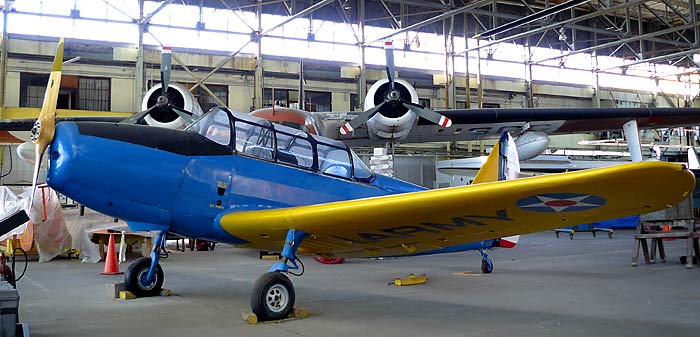
There was a story in the New York Times on Friday about Floyd Bennett Field, the decomissioned 1930s airfield on the border of Brooklyn and Jamaica Bay that is now a National Park. It reminded me that about two years ago I read a story in the Times about Floyd Bennett Field and resolved to go there. So on Saturday we finally went and found it to be a strange, flat landscape, filled with people pursuing their own agendas on the unprogrammed former runways, still marked with huge identifying numbers in dots. There were motorcyclists, bikers, people camping at mosquito-infested Camp Goldenrod, gardeners working on their plots in the 600-plot community garden, and any number of solo parked cars whose activities I would not want to investigate. Best of all from our point of view was Hangar B, built in 1941 by the Navy. It housed seaplanes in its early years, and today houses planes again: pre- and postwar aircraft being brought back to life by the all-volunteer Historic Aircraft Restoration Project (H.A.R.P.).
The volunteers are mostly men who served in World War II, flying the very planes they are now scrubbing, taping, welding, sanding, wiring back together. Photographs of all the volunteers in uniform are on the wall in the break room, and there was a natural camraderie among the workers and our tour guides. for my almost-two-year-old it was also like a hangar-full of admiring grandparents. To see these men in their 80s so intent on their task, and the beautiful, touchable results was inspiring. I don’t know their indovodual histories, but I imagine them coming back to the planes after years of civilian life and jobs far from the airstrip. There must have been so much skill hidden in their hands after those decades away, and that must have been a life-affirming discovery.
It reminded me very much of my own grandmother, also in her 80s, who recently returned to silversmithing after decades away. When she was young and married and living in Parkchester, my grandmother took classes at the Craft Students League, and made a number of lovely things, including a curvy mother-of-pearl ring she still wears, a very modern X-wing pin, and a heavy silver chain with elaborate links. Then she had three girls and moved to Hanover and eventually had a job at the college photo archives. She made many things, but never had time to get back to silver. Three years ago, when first my brother’s wife, then my cousin, and then I got pregnant, she took a silversmithing class, and found that despite 40 years and arthritis, she was as skilled as ever. Her ambitious project was silver baby cups for her three great-grandchildren born in 2007. Two have been finished and given to their intended recipients. I think my son will be getting the third for his second birthday. They are beautiful and modern, simple cylinders with half-circle handles. All that simplicity is much harder than the curves and folded edges of more traditional designs.
Going to class each week (and sometimes extra sessions on the weekends) has kept my grandmother interested through three long, dark Vermont winters. She has a fourth great-grandchild now, and a fifth on the way, but I hope this winter she will take a break and make herself something beautiful. I’m now in that middle of life, where work and children make it seem impossible to make something unnecessary. But I am hoping my hands remember how to do the drawing, ceramics, model-making, embroidery I used to do, and that those skills will be a comfort in my old age.
